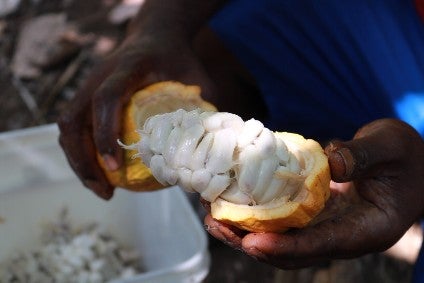
The innovation unveiled by Nestlé earlier this month, where refined sugar in chocolate is replaced with a dried fruit sugar obtained from cocoa pulp, is an ingenious technical innovation.
Nestlé claims Kitkat Chocolatory Cacao Fruit Chocolate, to be launched in Japan in the autumn, will be unique as the first chocolate bar to be made using cocoa beans and pulp as the only ingredients.
How well do you really know your competitors?
Access the most comprehensive Company Profiles on the market, powered by GlobalData. Save hours of research. Gain competitive edge.

Thank you!
Your download email will arrive shortly
Not ready to buy yet? Download a free sample
We are confident about the unique quality of our Company Profiles. However, we want you to make the most beneficial decision for your business, so we offer a free sample that you can download by submitting the below form
By GlobalDataRemarkable as the achievement may be, what it offers in terms of broader application and long-term benefit is far from clear. Nestlé is being careful about what it says about the process, which it has patented, not only to protect proprietary information but, quite possibly, because the company itself is far from certain exactly how the innovation might be further applied and scaled up.
Pulp sugar but still sugar
At the outset, the Swiss food giant is arguably being most explicit about what the innovation is definitely not, and that is the opportunity to market a chocolate product as containing no added sugar.
Alexander von Maillot, head of Nestlé’s strategic business unit for confectionery and ice cream, says the company is proud to have produced a “unique” chocolate made entirely from the cocoa fruit without adding refined sugar but stresses it will contain roughly the same amount of calories as a comparable product made with refined sugar.
“It is difficult to compare nutritional content at this stage as there is no final product on the market and it depends on what you then compare it with,” von Maillot tells just-food. “In a comparison with other 70% cocoa chocolates sweetened with refined sugar, the 70% dark chocolate with cocoa pulp has around the same calorie count, and generally slightly higher fat and somewhat lower total sugars, but depending on the product.”
Indeed, von Maillot is concerned some initial reporting seized on and misrepresented the issue of sugar content. “What some media have written is ‘no added sugar’ or ‘no sugar’,” he continues. “This is not correct and we do not want people to have the impression that the new chocolate contains no sugars. What we have said is that we are not adding any refined sugar, but rather using the natural sugar from the cocoa pulp to sweeten the chocolate. As with all chocolate, this is a treat and should be enjoyed in moderation as part of a healthy balanced diet.”
Challenge in realising benefits for farmers
Using both cocoa beans and pulp to produce chocolate should in theory have positive implications for farmers. Steve Osborn, director of UK-based food technology consultancy Aurora Ceres Partnership, sees the new process as a sustainability initiative as much as a technological innovation. “Waste valorisation is a key part of sustainability and is an area where some of the best innovations are emerging,” Osborn says. “Large food companies are criticised for many things and their investment in this type of technology is a key part of the journey to a much more circular economy.”
Once cocoa beans are harvested, farmers leave them in the pulp to ferment. However, not all the pulp is required for the fermentation. Nestlé has developed “a gentle mechanical process to extract and maintain the fresh quality of the pulp”, von Maillot explains. “It extracts the pulp but leaves enough around the beans for the fermentation.”
In principle, offering impoverished smallholder farmers in west Africa a high-value use of a waste product is significant but there are logistical challenges in rolling this out on a farm-by-farm basis. Nestlé declines to give further details of the drying process that allows the pulp to be made into a powder and used in chocolate production, other than to say it is does not involve the use chemicals. However, a Nestlé spokesperson did confirm the pulp needs to be collected quickly before it dries out.
“Perfecting the natural processing of the pulp to get the perfect texture and flavour in chocolate was a large part of the challenge,” von Maillot says. This would appear to make the speed and manner of collection of the pulp all the more critical. During development, Nestlé has obtained pulp from farms in Brazil but has not specified how the pulp was sourced and from what types of farm. The company says it intends to source pulp from other regions, including Africa, using the Nestlé Cocoa Plan infrastructure, which supports smallholder farmers.
Nestlé is now focusing attention on exactly how to source pulp from a large numbers of small producers in tropical heat. “We are working on sourcing the pulp from Nestlé Cocoa Plan farmers in Brazil and Africa. This would give the farmers an additional source of revenue from the same crop,” says von Maillot. “This is alongside our existing efforts to support farmers to improve their agricultural practices which leads to improved productivity and livelihoods.”
Fruitier taste and premium price
Keen to avoid any suggestion it is presenting a healthier product, and with some uncertainty over exactly how this innovation can be used as a means of boosting farmer incomes, Nestlé has focused the pre-launch marketing of Kitkat Chocolatory Cacao Fruit Chocolate on its unique formulation and the taste and texture characteristics created.
That this is a premium launch speaks to the higher costs of obtaining sugar from cocoa pulp, another factor that may limit the opportunities for scaling up. Nestlé has said it wants to apply the technology to other popular brands but has also made it clear these will be premium-priced offerings. “The cocoa pulp is a more expensive ingredient that gives the chocolate a special fruity, acidic note and replaces refined sugar,” says von Maillot. “As such, we plan to use it to create more premium chocolate offerings. We have not said any more about where the cocoa pulp might appear next, but watch this space.”
There has been some suggestion the use of pulp sugar will favourably boost the micronutrient profile of the reformulated chocolate, for instance, with higher levels of vitamins E and D, polyphenols and B vitamins. Similar claims are sometimes made for cacao juice, a drink made using cocoa pulp which has begun to build a niche presence.
When asked, von Maillot resolutely refuses to be drawn on the matter of a higher content of potentially beneficial micronutrients. “This is about providing a great-tasting pure, novel chocolate experience. We have found a way to make chocolate that uses just a single source – the cocoa fruit. The use of the cocoa pulp gives the chocolate a fruity, acidic note, with an intense cocoa flavour and a wonderful sweetness. Dark chocolate continues to grow globally and this new chocolate offers those dark chocolate lovers an original cocoa experience.”
Nestlé says the new product will have a higher percentage of cocoa butter but a lower level of total sugars than a standard chocolate bar owing to the sole inclusion of the dried fruit sugar. Independent food technology consultant Dr Julian Cooper suggests the reformulated chocolate is likely to have a higher fibre content. However, Cooper says any difference in micronutrient profile will be “minimal”.
Cooper suggests alluding to the micronutrient profile would be “very difficult” for Nestlé, as the company “would be making an implied health claim”. Like Osborn, Cooper emphasises the sustainability advantages of the new product. “They are maximising the natural resources they have so they are extracting value from their raw material which is to be applauded.” Nestlé has not produced a healthier chocolate, Cooper contends, but possibly “a more ethical chocolate”.
Increased focus on utilisation of waste
That cocoa pulp is only being used in premium products might suggest farmers should expect a fairly hefty return for the ingredient. The reality, however, is that cocoa farmers receive only a minute proportion of the value of any chocolate product and, while the pulp is adding value, utilising it is a relatively expensive process which has also involved R&D investment.
This is certain to impact on the dividend Nestlé will be able to offer farmers, though the company will be aware campaigners could draw potentially embarrassing comparisons between what farmers receive and the retail price of the premium products this new ingredient makes possible. The effective restriction of cocoa pulp to niche premium products will also ultimately limit the numbers of farmers that can benefit.
However, what Nestlé has done underlines the nutritional value in this waste product, if that nutritional content can be released and utilised through innovation. “With growing population and the impact that this will have on food availability it should always be considered wrong that any nutritive substance is discarded,” Osborn says.
This development also speaks to the importance of helping farmers realise maximum value from waste products. In comparison with the daunting structural problems facing cocoa production in west Africa, relating to poverty, low yields, lack of training, migration of younger populations out of farming and the need for extensive new planting, realising a relatively small rise in the value obtained from waste products may seem negligible.
However, the scale of cocoa’s overall problems may indeed have contributed to a lack of investment in more detailed and highly specialised aspects of waste utilisation. Moreover, cocoa farmers are among the poorest in the world so any improvement, no matter how small, would appear to be worthwhile.
Among a number of research projects and initiatives related to maximising the value of cocoa pods have been two waste-to-energy projects, one in Cote d’Ivoire and another in Ghana, launched earlier this year and led by the University of Nottingham.
The aim of the project in Ghana is to initiate the development of an “entirely new bio-fuel industry”, using discarded cocoa pod husks as biomass, that will “also improve socio-economic stability for cocoa producers”.
Project lead Professor Jo Darkwa contends Ghana’s huge production of cocoa pod husks has been underutilised as a resource. “The cocoa pod husks electricity project could therefore go a long way towards reducing poverty in the cocoa growing communities,” Prof. Darkwa says.
It is well known poorer farmers are further disadvantaged because they lack the training to take advantage of more efficient agricultural techniques. This also applies to the more efficient utilisation of waste materials. Farmers are unaware of ways to make improvements owing to “a combination of lack of knowledge, skills and basic services”, Prof. Darkwa says.
However extensive the application of Nestlé’s new process becomes among cocoa farmers in west Africa, it may have merit simply in illustrating the value optimising the use of waste materials can create.




